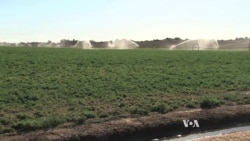The drought in California is moving into its fourth year. While the state's governor is mandating a reduction in urban water use, most of the water used in California is for agriculture.
But both city dwellers and farmers are feeling the impact of the drought. Some experts say the state’s water system was not created to handle long periods of drought.
The drought in California worries almost every farmer in the state, including Ventura County avocado grower Ed McFadden.
“It’s a big concern and a lot of us are losing sleep. If you look around here you can see trees that have been here for decades," said McFadden.
What happens to the crops in California has impacts that extend far outside the state, according to John Krist with the Farm Bureau of Ventura County.
"We grow half the nation’s fresh fruits and vegetables," said Krist.
Krist said the drought has become a hardship for many farmers in the state.
“Agriculture already had been cut back.There were almost no deliveries [of water] from the state and federal projects last year and half a million acres was left fallowed. That’s a real impact," he said.
State and federal agencies control the water used by many California farms. That water comes from places such as Northern California and the Colorado River.
“I would say that the system for capturing, storing and transporting water in California that we have - which a lot of the big stuff dates back to the 50s, 60s - was great at the time given what was known, but obviously we live in a different world than we did then," said Krist.
The system has depended on melted snowpack as the water source and was not engineered for long periods without precipitation, aid Stephanie Pincetl of the Institute of the Environment and Sustainability at the University of California Los Angeles.
“In the 20th century, there was more rainfall than historically and so we engineered these systems to manage that and we did not anticipate the kind of growth in agriculture or in populations or climate change," said Pincetl.
Change that means warmer, dryer weather.
"I think it is inevitable. We need to look at different ways of storing water," said Krist.
Pincetl suggests looking at California’s groundwater basins.
“We really need to use what we have in the ground, in those ground water basins, to create what they call conjuctive water management - surface and ground water together," she said.
Ed McFadden says unlike many California agricultural regions, farms in Ventura County depend almost entirely on groundwater. He is doing better than his counterparts in other counties.
“So far we’ve been doing pretty well. We’ve got a good crop that we’re picking this year," he said.
The water table, though, is approaching historic lows. Farmers in the region say it is critical to carefully and fairly manage the water they have - a necessity for all farmers in the state, regardless of where their water comes from.










